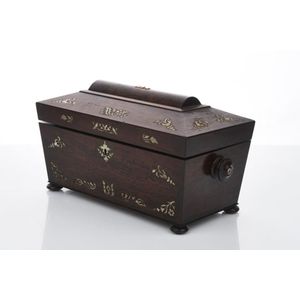Victorian Rosewood Tea Caddy with Inlay and Glass Bowl
Victorian rosewood tea caddy 19th century of sarcophagus form with Mother-of-pearl inlay, interior with pressed glass bowl flanked by two canisters, height 22 cm, width 33 cm, depth 18 cm. Provenance: David Jones Gallery, Sydney. Private Collection, Sydney.
You must be a subscriber, and be logged in to view price and dealer details.
Subscribe Now to view actual auction price for this item
When you subscribe, you have the option of setting the currency in which to display prices to $Au, $US, $NZ or Stg.
This item has been sold, and the description, image and price are for reference purposes only.
- Victorian Period - The Victorian period of furniture and decorative arts design covers the reign of Queen Victoria from 1837 to 1901. There was not one dominant style of furniture in the Victorian period. Designers used and modified many historical styles such as Gothic, Tudor, Elizabethan, English Rococo, Neoclassical and others, although use of some styles, such as English Rococo and Gothic tended to dominate the furniture manufacture of the period.
The Victorian period was preceded by the Regency and William IV periods, and followed by the Edwardian period, named for Edward VII (1841 ? 1910) who was King of the United Kingdom and the British Dominions and Emperor of India for the brief period from 1901 until his death in 1910. - Rosewood - A dense timber that varies in shade to very light brown to almost black. When rosewood is cut and sanded the colour of the timber will turn black, and after polishing and exposure to daylight, the surface will gradually lighten over time to light brown with black streaks.
The name comes from the odour emanating from the timber when it is planed, sanded or cut.
Rosewood was very popular for use in Victorian furniture in the second half of the 19th century, and at that time most of the rosewood was imported from Brazil. However it also grows in India and Indonesia.
It is used in the sold for chairs and table legs, but for carcase furniture such as side cabinets and bookcases, and for table tops it is always used as a veneer. - Mother-Of-Pearl - Mother-of-pearl, technical name "nacre", is the inner layer of a sea shell. The iridescent colours and strength of this material were widely used in the nineteenth century as an inlay in jewellery, furniture, (especially papier mache furniture) and musical instruments.
In the early 1900s it was used to make pearl buttons. Mother-of-pearl is a soft material that is easily cut or engraved.
Nowadays it is a by-product of the oyster, freshwater pearl mussel and abalone industries. - Pressed Glass - Pressed glass is a type of glassware that is produced by pressing molten glass into a mould. This manufacturing process involves using a mould to shape and form the glass while it is still in a semi-liquid or molten state. The glass is pressed into the mould to take on its design and texture.
The use of moulds allows for the mass production of glass items with consistent designs. Pressed glass became popular in the 19th century as a more economical alternative to hand-blown glass, as it allowed for faster and more efficient production. This method was widely used for creating various glass objects, including dishes, bowls, vases, and decorative items.
Pressed glass can have intricate patterns and designs, and it has been used for both utilitarian and decorative purposes. While it may not have the same artisanal quality as hand-blown glass, pressed glass has its own charm and has been a significant part of glassware history.
This item has been included into following indexes:
